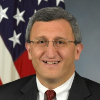Officials
Offical

The Defense Advanced Research Projects Agency (DARPA), the military’s secretive, high-tech operation responsible for inventing the forerunner to the Internet (ARPAnet) and the technology behind the stealth fighter, unmanned drone aircraft, global positioning satellites and the M16 rifle, has a new acting director. Kaigham (Ken) J. Gabriel, who served at DARPA previously, is widely regarded as the founder of Microelectromechanical Systems (MEMS), which is the technology of very small devices that generally range in size from 20 micrometers to one millimeter. Gabriel was named acting director after the departure of Regina Dugan, who is being investigated for alleged conflicts of interests first reported by AllGov, which arose because she was owed $250,000 by her family company, RedXDefense, which has won $1.7 million worth of contracts with the agency since Dugan took over in July 2009. Gabriel himself was criticized at the beginning of the affair, when he characterized the situation as “something that is prevalent,” and “not that big of a deal, frankly.”
Born circa 1955, Gabriel earned an S.M. and a Ph.D. in Electrical Engineering and Computer Science from the Massachusetts Institute of Technology in 1979 and 1983, respectively. In 1985 he joined AT&T Bell Labs in the Robotic Systems Research Department, where he pioneered the field of MEMS. During a sabbatical year from Bell Labs, Gabriel was a visiting associate professor at the Institute of Industrial Science at the University of Tokyo in Japan.
Gabriel left Bell Labs in 1991, spending a year as a visiting scientist at the Naval Research Laboratory. From 1992 to 1997, he served his first stint at DARPA, where he started and managed the MEMS Program, taking it from a budget of zero to more than $70 million per year and more than 80 projects by 1997. Gabriel was deputy director of the Electronics Technology Office from 1995 to 1996, and director from 1996 to 1997.
In 1997, Gabriel was jointly appointed professor of Electrical & Computer Engineering and Robotics at Carnegie Mellon University, where he continued his work on MEMS. After the terrorist attacks of September 11, 2001, Gabriel and his wife, Christina, organized an Office for Security Technologies, the purpose of which was to match Carnegie Mellon experts with government agencies that might need them.
In 2001, Gabriel co-founded Akustica, a Pittsburgh-based company that develops MEMS sensors for consumer electronics products. Akustica, of which Gabriel was chairman and chief technical officer, pioneered the use of digital silicon microphones and shipped more than 5 million units to the PC/notebook industry before being acquired by Robert Bosch in 2009.
He is a founding director of Optical Micro Machines and a founder of Xactix, Inc., and serves on the strategic advisory boards of Microcosm Inc., Crossbow Technology, and Network Elements. Gabriel is the co-founding executive director of the MEMS Industry Group, the principal trade organization representing the MEMS industry globally.
Gabriel was named deputy director of DARPA in July of 2009 when Regina Dugan became its director His wife, Christina Gabriel, had a long involvement with Carnegie Mellon University, including serving as vice provost and chief technology officer. She is currently president of the University Energy Partnership, a collaborative effort of Carnegie Mellon University, the University of Pittsburgh, Penn State University, Virginia Tech, and West Virginia University.
-Matt Bewig
The Funder (by Louise Rafkin, Forbes)
Statement Before the House Subcommittee on Emerging Threats and Capabilities (pdf)
Darpa Warns: Your iPhone Is a Military Threat (by Noah Shachtman, Wired)
- Latest News
- D.C. Public Schools will Teach all Second-Graders to Ride a Bike
- New Rule in Germany Limits Sales of Sex-Themed E-Books to 10pm to 6am
- What Happened to the 6-Year-Old Tibetan Boy the Chinese Government Kidnapped 20 Years Ago?
- U.S. Ambassador to Turkey Photoshops his Hair Color to Mock Turkish Mayor
- Mystery Artist Calls Attention to Unfixed Potholes by Drawing Penises around Them





